I have a dictionary:
data = {"Angles":
{"Hip": ["x", "y", "z"],
"Knee": ["x", "y", "z"],
"Ankle": ["x", "y", "z"]},
"Moments":
{"Hip": ["x", "y", "z"],
"Knee": ["x", "y", "z"],
"Ankle": ["x", "y", "z"]},
"Powers": {"Hip": ["z"],
"Knee": ["z"],
"Ankle": ["z"]}}
That I am trying to place on a tkinter GUI that would look something like this:
In a grid formation that looks something like this.
I'm struggling to figure out how to stagger the items/elements of the dictionary keys/items so that they would appear in the correct grid formation.
So far, I've tried:
import tkinter as tk
from tkinter import ttk, StringVar, OptionMenu
# Create the Root Window
root = tk.Tk()
root.geometry("1200x600")
root.resizable(True, True)
root.title("Choose Model Outputs")
class ChooseModelOutputs:
def __init__(self, master):
# Create the dictionary
self.data = {"Angles":
{"Hip": ["x", "y", "z"],
"Knee": ["x", "y", "z"],
"Ankle": ["x", "y", "z"]},
"Moments":
{"Hip": ["x", "y", "z"],
"Knee": ["x", "y", "z"],
"Ankle": ["x", "y", "z"]},
"Powers": {"Hip": ["z"],
"Knee": ["z"],
"Ankle": ["z"]}}
# Place the outputs on the GUI across the top
for col, output in enumerate((list(self.data.keys())), start=1):
self.output_headers = ttk.Label(
root, text=output
)
self.output_headers.grid(column=1 + col * 2, row=0, pady=5, padx=20)
for row, joint in enumerate(list(self.data[output].keys())):
self.joint_row_headers = ttk.Label(root, text=joint)
self.joint_row_headers.grid(column=col * 2, row=row + 1, pady=5, padx=20)
which works for getting an image like this:
But now I'm stuck on how to get the actual list elements to populate further.
I've tried this:
import tkinter as tk
from tkinter import ttk, StringVar, OptionMenu
# Create the Root Window
root = tk.Tk()
root.geometry("1200x600")
root.resizable(True, True)
root.title("Choose Model Outputs")
class ChooseModelOutputs:
def __init__(self, master):
# Create the dictionary
self.data = {"Angles":
{"Hip": ["x", "y", "z"],
"Knee": ["x", "y", "z"],
"Ankle": ["x", "y", "z"]},
"Moments":
{"Hip": ["x", "y", "z"],
"Knee": ["x", "y", "z"],
"Ankle": ["x", "y", "z"]},
"Powers": {"Hip": ["z"],
"Knee": ["z"],
"Ankle": ["z"]}}
# Place the outputs on the GUI across the top
for col, output in enumerate((list(self.data.keys())),
start=1):
self.output_headers = ttk.Label(
root, text=output
)
self.output_headers.grid(column=1 + col * 2, row=0,
pady=5, padx=20)
for row, joint in
enumerate(list(self.data[output].keys())):
self.joint_row_headers = ttk.Label(root,
text=joint)
self.joint_row_headers.grid(column=col * 2,
row=3*row
+ 1, pady=5, padx=20)
for row2, axis in enumerate(list(self.data[output]
[joint]), start=1):
self.axis_row_headers = ttk.Label(root,
text=axis)
self.axis_row_headers.grid(column=1 + col * 2,
row=row2, pady=5, padx=20)
_ = ChooseModelOutputs(root)
I'm not sure how to get the repeating "x", "y", "z" for the respective joints.
Thanks in advance!


